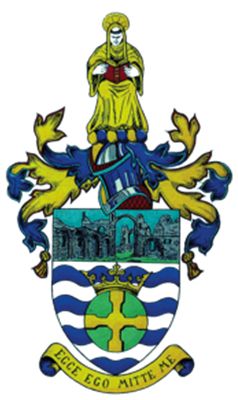Holy Island: Difference between revisions
Knorrepoes (talk | contribs) m (Text replacement - "50 px|link=United Kingdom[[Category" to "[[Category") |
Knorrepoes (talk | contribs) m (Text replacement - " :" to ":") |
||
| (5 intermediate revisions by the same user not shown) | |||
| Line 1: | Line 1: | ||
''' {{uc:{{PAGENAME}}}} ''' (Parish Council) | ''' {{uc:{{PAGENAME}}}} ''' (Parish Council) | ||
District : [[Berwick-Upon-Tweed (Borough)|Berwick-upon-Tweed]] | District: [[Berwick-Upon-Tweed (Borough)|Berwick-upon-Tweed]] | ||
[[File:holyisland.jpg|center|Arms (crest) of {{PAGENAME}}]] | [[File:holyisland.jpg|center|Arms (crest) of {{PAGENAME}}]] | ||
| Line 10: | Line 8: | ||
'''Arms''': Barry wavy argent and azure, a pomeis ensigned with an ancient crown and charged throughout with a Celtic cross Or; on a chief also azure in a landscape a representation of the ruined Priory of Lindisfarne proper. <br> | '''Arms''': Barry wavy argent and azure, a pomeis ensigned with an ancient crown and charged throughout with a Celtic cross Or; on a chief also azure in a landscape a representation of the ruined Priory of Lindisfarne proper. <br> | ||
'''Crest''': On a wreath Or and azure, A monk seated affrontee and habited in a saffron-coloured robe proper, behind the head a nimbus Or, and holding in the hands an open book gules, garnished gold. <br> | '''Crest''': On a wreath Or and azure, A monk seated affrontee and habited in a saffron-coloured robe proper, behind the head a nimbus Or, and holding in the hands an open book gules, garnished gold. <br> | ||
'''Motto''': Ecce ego, mitte me | '''[[:Category:Mottoes all|Motto]]''': Ecce ego, mitte me | ||
===Origin/meaning=== | ===Origin/meaning=== | ||
The arms were granted on June 10, 1959. | The arms were granted on June 10, 1959. | ||
In the upper part of the shield shows an image of the ruined priory on the island. The Holy Island of Lindisfarne has a recorded history from the 6th century AD; it was an important centre of Celtic Christianity under Saints Aidan of Lindisfarne, Cuthbert, Eadfrith of Lindisfarne and Eadberht of Lindisfarne. After the Viking invasions and the Norman conquest of England, a priory was re-established. The lower part of the shield shows the Crown of the Northumbrian King Saint Oswald and a Saint Cuthbert’s or Lindisfarne Cross. These are surrounded by waves of the sea. | |||
The crest shows a Monk in a golden yellow robe and holding the Lindisfarne Gospels, created at some point in the early 8th century, the famous illuminated manuscript, is an illustrated Latin copy of the Gospels of Matthew, Mark, Luke and John. The artist was possibly Eadfrith, who later became Bishop of Lindisfarne. | |||
The motto is from the Old Testament, Isaiah Chapter 6 Verse 8, and was chosen by Hugh Ashdown, the Bishop of Newcastle. | |||
{{media}} | {{media}} | ||
[[Literature]] : Briggs, 1971 | [[Civic Heraldry Literature - United Kingdom|'''Literature''']]: | ||
Briggs, 1971 | |||
[[Category:United Kingdom Municipalities H]] | [[Category:United Kingdom Municipalities H]] | ||
[[Category:England]] | [[Category:England]] | ||
[[Category:Granted 1959]] | [[Category:Granted 1959]] | ||
Latest revision as of 11:14, 11 August 2024
HOLY ISLAND (Parish Council)
District: Berwick-upon-Tweed
Official blazon
Arms: Barry wavy argent and azure, a pomeis ensigned with an ancient crown and charged throughout with a Celtic cross Or; on a chief also azure in a landscape a representation of the ruined Priory of Lindisfarne proper.
Crest: On a wreath Or and azure, A monk seated affrontee and habited in a saffron-coloured robe proper, behind the head a nimbus Or, and holding in the hands an open book gules, garnished gold.
Motto: Ecce ego, mitte me
Origin/meaning
The arms were granted on June 10, 1959.
In the upper part of the shield shows an image of the ruined priory on the island. The Holy Island of Lindisfarne has a recorded history from the 6th century AD; it was an important centre of Celtic Christianity under Saints Aidan of Lindisfarne, Cuthbert, Eadfrith of Lindisfarne and Eadberht of Lindisfarne. After the Viking invasions and the Norman conquest of England, a priory was re-established. The lower part of the shield shows the Crown of the Northumbrian King Saint Oswald and a Saint Cuthbert’s or Lindisfarne Cross. These are surrounded by waves of the sea.
The crest shows a Monk in a golden yellow robe and holding the Lindisfarne Gospels, created at some point in the early 8th century, the famous illuminated manuscript, is an illustrated Latin copy of the Gospels of Matthew, Mark, Luke and John. The artist was possibly Eadfrith, who later became Bishop of Lindisfarne.
The motto is from the Old Testament, Isaiah Chapter 6 Verse 8, and was chosen by Hugh Ashdown, the Bishop of Newcastle.
Contact and Support
Partners:
Your logo here ?
Contact us
© since 1995, Heraldry of the World, Ralf Hartemink 
Index of the site
Briggs, 1971










